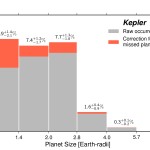W. M. Keck Observatory press release…
A team of astronomers from the University of California, Berkeley and the University of Hawaii at Manoa has found that 17 percent of all sun-like stars have planets one to two times the diameter of Earth in close orbits. The finding, based on an analysis of the first three years of data from NASA’s Kepler mission and the W. W. Keck Observatory on the summit of Mauna Kea, Hawaii, was announced at the American Astronomical Society meeting in Long Beach, California this week.
While other studies had shown that planets around stars are common in our galaxy, until this study, it remained unclear if this is true for Earth-size planets.

To find planets, the Kepler space telescope repeatedly images 150,000 stars in a small region of the sky. It looks for a tiny dip in each star’s brightness that indicates a planet is passing in front of it, much like Venus passed between Earth and the sun last summer.
We took a census of the planets detected by the Kepler Space Telescope,” said Howard. “Erik Petigura wrote a new pipeline to detect the shallow dimmings of Earth-size planets in Kepler photometry. With his efficient and well-calibrated pipeline we could confidently report the size distribution of close-in planets down to Earth-size. The result is that Earth-size planets are just a common as planets twice Earth size. Remarkable.”
